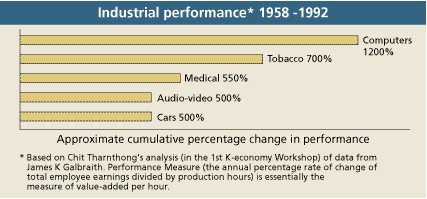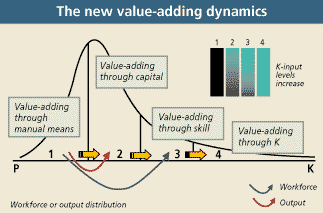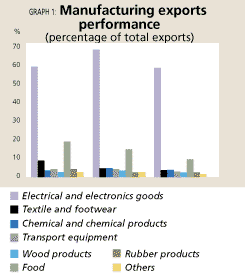|
Dynamos of The Future
The Competitive Advantage
Key Technology
Global Economy Prospect
K-Economy
New Economy
Last Update:
10 May, 2000
| |
The Edge
January 10 , 2000 |
Creating
a K-Economy
By Dr Wan Latifah Wan Mohamad
|
As we move rapidly into a
new paradigm in the world economy, The Edge is starting a series on the Knowledge
(K)-Economy. We hope that this series of articles by various industry experts and
commentators, presented with the cooperation of the National Information Technology
Council (NITC) and Mimos Bhd, will create awareness among our local entrepreneurs and
companies of the challenges and opportunities ahead. The dramatically changing world
demon- strates the pace, direction and quanta of change at the macroeconomic level.
At the personal level, we seem to be witnessing an uncharted revolution in the products
that we consume as well as in the way we live and do business. The challenge of the 21st
century for Malaysia is to define a niche area to form a new competitiveness paradigm.
The driving force of change is the advancement in technologies, especially information and
communication, as well as computing, biotechnology, telecommunications and transportation.
Transnationalisation of these technologies and increasingly democratised means of design,
production and distribution are the global forces of change.
On the soft side, simultaneous change in consumer behaviour is observed, shifting towards
a new value-driven tier of consumers. The trend is towards willingness to pay more for the
right fit and embedded customer information in products and services.
On human capital, the change is towards development of high skills and cognition. At the
industry level, the trend is to embed customer information, shifting from “make and
sell” to “sense and respond” or from mass production to mass customisation.
In aggregate, goods-based production makes way for knowledge-based services.
In the new environment, only a few things really matter — “primary ingredients”,
among which are information and knowledge, that separate success from failure.
Malaysia’s aspiration has been to leapfrog from the industrial era to a
post-industrial era with an economy driven by information and knowledge, as recognised by
the National Information Technology Agenda, 1994. The time is right for such a
transformation. The Multimedia Super Corridor is a strategic initiative to shift towards a
knowledge-based socio-economy.
The new strategic agenda comprises e-economy, e-learning, e-community, e-public services,
e-learning and e-sovereignty. Postgraduate education, research and development, and design
houses are a knowledge-intensive business.
Analysing the
battleground from abroad
Malaysia is predominantly practising what we generically term a Production (P) economy, be
it in the manufacturing, services or agricultural sectors.
Advanced countries like the US have been locating their P-work in low-cost locales such as
Southeast Asia, China and India. Low-cost workforce is the key to their positioning
decisions and the criterion for competitive advantage.
The advanced countries mainly retain Knowledge (K)-work such as design and development,
computer software development, consultancy work, advertising and media productions, and
education.
A study shows that K-work has greater wages per worker than P-work, even when earnings or
industrial performance of P-industries increased. Low-wages of P-work matched against
high-gains of K-work further widens the gap between P- and K-work earnings, so the total
value retained in the P-economies is relatively low compared with that of the K-economies.
In total, the P- to K-wage differential reflects the competitive advantage of an economy
in the global economy context.

The point we are making is
that the above is the key to understanding how economic spoils have been shared across the
value chain.
The planning architecture for our new competitive environment underlines adjustments for
new trends, understanding and actionable policy framework. Ideas in modern currency such
as knowledge-based transformations must be tempered by realistic understanding of gaps and
goals, and supported by practicable plans. The traditionally arbitrary taxonomy, too,
needs rethinking.
For example, assume that our economy has four workers: A makes computers and earns RM100,
B sells computers and earns RM200, C builds houses and earns RM300, and D paints houses
and earns RM150. A horizontal and vertical classification would yield unhelpful
comparative data between manufacturing and services.
Though cluster analysis can be useful, the key is to understand what grouping’s
behaviour is driven by what distinct factors. An analysis of the US economy (see graph)
may prove surprising.
In the next part, we shall analyse the battlegrounds to set the context further.
Dr Wan Latifah Wan
Mohamad is with NITC/Mimos Bhd |
|
| The Edge : April 17, 2000 |
K-Economy
Defining the K-economy
Intellectual assets to be key source of wealth creation By
Dr Wan Latifah Wan Mohamed |
Having set the con-text for a K-economy in previous articles, and
knowing that value-add has been exhausted in the P-economy and hence created the need for
a shift to the K-economy, we now discuss what the K-economy is all about. Attempting a definition
The OECD (Organisation for Economic Cooperation and Development) defines a knowledge-based
economy as the “production, utilisation and distribution of knowledge in all
activities”.
We can interpret it as intellectual capital or simply, knowledge capital or assets as the
key source of value. Intellectual assets, rightly used, produced and distributed, will
then be the key source of wealth creation.
From this simple definition, there is a myriad of things that we can do to build knowledge
assets in the economy and use them to create value or even wealth.
Two key questions arise:
1. How do we build intellectual assets/capital?
 | How do we make intellectual assets flow and
be dynamic (distribution or dissemination)?
|
 | How do we apply it (utilisation)?
|
2. How do we determine value, and translate it into wealth?
Knowledge originates from data and information. Data is numbers, words or sounds. Its
value is determined by how it is processed, stored, or otherwise manipulated. When
arranged into meaningful patterns, it creates information. Data and information are stock.
The utilisation, distribution and reproduction of data and information are the dynamic
processes that add further value. Knowledge is created by learning and applying one’s
skill in using information, and building for a purpose.
Learning is the process that adds further value to knowledge. The more the knowledge
flows, the more value is created. Knowledge, with further learning, coupled with
experience and spiritual development, may create wisdom.

So, knowledge assets are built
through continuous learning. To learn, we have to go back to the fundamentals, such as
conducting research and having some social interaction to “test” research
findings so as to add more value. The easiest way is by reading and the fastest way to
understand what you learn is by discussing and writing what you have read. This is when
you begin to formulate your own ideas.
An individual who continues to learn can make all the difference (be a change agent) to a
society or organisation. He or she can add or create value qualitatively and
quantitatively. If everyone in organisation did this, knowledge accumulation would be
exponential, not only due to collective knowledge and learning, but also because of
optimal complementarity. For example, if I have knowledge on K-economy, and you have
knowledge on K-society, and we exchange ideas with the aim of helping the country to
achieve both, that is a form of optimal complementarity.
When we refer to the learning-thinking-writing-thinking processes, we are referring to
mental processes. We are touching on cognitive science, explaining how the human mind
works. Focussing on the cognitive abilities of an individual gives rise to a new pedagogy
known as constructivism, which emphasises a learner’s metacognitive skills. Smartness
is the result of meaningful knowledge construction, which happens only in a conducive
learning environment.
All this answers the first question, so that now, we can generalise and raise the
discussion to a higher level, that is, knowledge. Further, rich and conducive learning
environments embody qualitative characteristics which provide the chance for
breakthroughs. They are the means to increasing returns in an increasingly complex global
environment. We shall deal with this later, in a more advanced discussion.
Traditionally, when “labour” is put to perform a task, there is output. If we
are not satisfied with the output, we give “labour” capital to buy tools so he
can increase output. If still we are dissatisfied, we train or educate him to work more
efficiently. If this fails, we give him technology and knowledge. He now becomes “a
knowledge worker” who can now do more things in less time, hence reaping benefits
(not just output) and lowering costs — which is the traditional “efficiency and
effectiveness” argument in economics.
The diagram shows how we can shift the P-work to the K-work through the traditional
factors of production, but with the addition of skills and knowledge.
The bell curve shows the skill spectrum, from low to high skill. The distribution of the
population is somewhere between the low and the high skill, with most of it bunched at the
low skill. It is reasonable to think in terms of value-adding skills while in transition
to the K-economy. Continuous learning enables one to step up one category. For example,
most of the skill population in agriculture do not have the ability to jump one step from
P-agriculture to K-agriculture. It may be easier to move from P-agriculture to P-factory.
The biggest challenge is, then, how to shift P-agriculture to at least the lower ends of
K-agriculture.
The diagram depicts the most obvious sources of value-add (as well as value creation) that
is skill and knowledge. Combining some of the factors which constitute value (as discussed
in the second article of this series) and today’s analysis, we look at a formulation
of the term “value”, and hence, wealth creation:
 | value-add and new value creation —
quantitative and qualitative — through skill and knowledge;
|
 | prices versus supply and demand — they
are becoming more and more the reverse of the traditional principles — quantitative
— value generated due to decreasing importance in price factor;
|
 | new value-driven tiers of consumers —
consumers themselves are value providers, through self-learning, smartness, metacognitive
skill, etc;
|
 | knowledge/information value —
qualitative and quantitative — knowledge flows, optimality complementarity;
|
 | societal/cultural values to be translated
into qualitative value and emphasis on creativity, conducive knowledge-development
environment within society, self-learning, etc; and
|
 | environmental improvements/preservation
— perhaps more towards qualitative value — knowledge development on environment
and health.
|
With the above questions answered, we can start building a K-economy according to
our own mould, and find niche areas that we can focus development on.
Dr Wan Latifah Wan Mohamed is
with NITC/Mimos Bhd |
| The Edge : January 31, 2000 |
K-Economy
Analysing the battleground
We continue our series on the knowledge economy, presented with the
cooperation of the National Information Technology Council (NITC) and Mimos Bhd By
Dr Wan Latifah Wan Mohamad |
 In the last article (Issue 275, Jan 10), I said the
arbitrary traditional taxonomy needs re- thinking. In a diagram- matic form, with refer-
ence to the last article’s example, horizontal classification means “clustering”
the manufacture of computers and construction of houses with services. Vertical
classification means grouping the manufacture and services of two different physical
products. In the last article (Issue 275, Jan 10), I said the
arbitrary traditional taxonomy needs re- thinking. In a diagram- matic form, with refer-
ence to the last article’s example, horizontal classification means “clustering”
the manufacture of computers and construction of houses with services. Vertical
classification means grouping the manufacture and services of two different physical
products.
In the new K-economy, analysis and groupings of activities have to be more realistic; take
an atomistic approach (as micro as possible) and position in a flexible way; and “clustering”
should be based on common behaviour and characteristics.
In fact, generally, many more of the economic principles need rethinking and their
analysis needs to suit current and future developments towards a K-based socio-economy.
Value, for example, becomes quite a complex item in a networked economy. What constitutes
value should be analysed in detail so that we can create some kind of formula. Some items
about value that I can think of, for now:
 |  Value-add — quantitative; Value-add — quantitative;
|
 | New value creation — quantitative and
qualitative;
|
 | Prices versus supply and demand — they
are becoming more and more of the reverse of the traditional principles —
quantitative;
|
 | New value-driven tiers of consumers;
|
 | Knowledge/information value —
qualitative and quantitative;
|
 | Societal/cultural values to be translated
into qualitative value and to give emphasis on creativity, human cognition and so on; and
|
 | Environmental improvements/preservation
— perhaps more toward qualitative value.
|
In the Malaysian context, lessons of the past tell us not to depend on one fixed
internationally-prescribed growth model and no one growth model can sustain successful
development.
Key to this aspect is the over-dependence of information-gathering based on past data for
current or future course of action. While historical data has some value, the complete
value of an analysis is its ability to postulate future conditions (foresights) based on
certain assumptions (some assumptions are obvious).
 Evolving knowledge
and learning are, thus, key to successful sustenance of value, adding value or creating
value in the entire economy. Evolving knowledge
and learning are, thus, key to successful sustenance of value, adding value or creating
value in the entire economy.
An analysis of the past shows that:
- The manufacturing and services
sectors have been pushed to increase productivity and value-add. However, the recent trend
indicates that the manufacturing sector loses its competitiveness prior to an economic
downturn, as evidenced by declining growth rates. The “star” performer, the
electronics and electrical sector (Graph 1), loses competitiveness in terms of wages per
worker and value-add when seen in the global context. The wages per worker in Malaysia is
US$4,000 compared with its global counterpart of US$20,000 on average. The value-add for
the industry for Malaysia is US$15,000 compared with its global counterpart of US$100,000
on average. The services sector’s contribution to growth domestic product (GDP) has
been very small and performance on the current account balance has been negative in
history if taken in aggregation, although very few sub-sectors are performing well. That
is to say, the external performance has always been “eroding foreign exchange”
(Graphs 2 and 3). In value terms or in terms of contribution to GDP, it is far below those
of newly-developing economies;
- The aim of the Second Industrial
Masterplan is to move towards high technology with capital-intensive manufacturing —
hence, materialising to the extent that more capital invested adds more value, but not to
the extent of creating more value or an exponential increase in it, because the right kind
of skills are just not available. Human capital is still the “lagging” factor
and there is a mismatch of skills. Our concentration of human capital is not in the
highly-skilled, nor the very low-skilled category. It is suggested that the kinds of goods
produced and exported need re-examining because we are now competing with countries having
either very cheap labour or highly-skilled human resources. The key question remains as to
how to move resources to where they need to be — capital-intensive and high-tech
manufacturing;
- Gaps in skills persist and the skew
is still towards the production of traditional arts and social sciences;
- Extensive information on each
services sub-sector is not easily available; and
- All sectors of the economy are
distinctive stand-alones and hardly interlinked... hence, lacking collaboration;
this contributes to multi-level intermediaries and wasted resources.

Dr Wan Latifah Wan Mohamad is
with NITC/Mimos Bhd |
  
|
